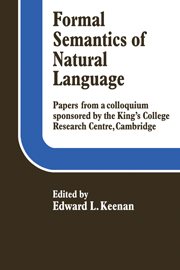Book contents
- Frontmatter
- Contents
- Notes on the contributors
- Acknowledgements
- Introduction
- I QUANTIFICATION IN NATURAL LANGUAGE
- II REFERENCE AND CROSS REFERENCE
- Deixis as the source of reference
- Referential constraints on lexical items
- On generics
- Quantifiers, definite descriptions, and reference
- III INTENSIONAL LOGIC AND SYNTACTIC THEORY
- IV QUESTIONING MODEL THEORETIC SEMANTICS
- V PRAGMATICS AND SENTENCES IN CONTEXT
- VI SEMANTICS AND SURFACE SYNTAX
Quantifiers, definite descriptions, and reference
Published online by Cambridge University Press: 05 November 2011
- Frontmatter
- Contents
- Notes on the contributors
- Acknowledgements
- Introduction
- I QUANTIFICATION IN NATURAL LANGUAGE
- II REFERENCE AND CROSS REFERENCE
- Deixis as the source of reference
- Referential constraints on lexical items
- On generics
- Quantifiers, definite descriptions, and reference
- III INTENSIONAL LOGIC AND SYNTACTIC THEORY
- IV QUESTIONING MODEL THEORETIC SEMANTICS
- V PRAGMATICS AND SENTENCES IN CONTEXT
- VI SEMANTICS AND SURFACE SYNTAX
Summary
When the Messenger in Through the Looking Glass told the King that nobody walked faster than he did, Alice was puzzled that the King accused the Messenger of being a liar: on the grounds that if nobody walked faster than he did, then nobody would have got there first. Clearly NPs like nobody (if indeed they are NPs) do not refer in any straightforward way. I shall, to give a label, call such surface structure NPs as nobody, all men, every stupid academic ‘quantified NPs’: they correspond to what Geach (following W. E. Johnston) calls ‘applicatival phrases’ (being phrases formed from a general term plus an applicative). But if quantified NPs do not refer in any straightforward way, do they refer at all? Moreover, in general what requirements does the presence of such NPs impose on the semantics of host sentences?
Clearly anything like an adequate answer to such questions would take us over much ground. I shall here confine myself to examining a small subset of the possible concatenations involving quantified NPs. In so doing I hope to shed some light on the behaviour of definite descriptions in certain roles.
One possibility for concatenation with quantified NPs has been much discussed in the literature of linguistics: that involving the co-habitation within a sentence of two quantified NPs having superficially the same structure, and being composed of the same morphological units.
Information
- Type
- Chapter
- Information
- Formal Semantics of Natural Language , pp. 112 - 120Publisher: Cambridge University PressPrint publication year: 1975
